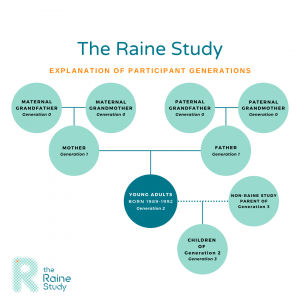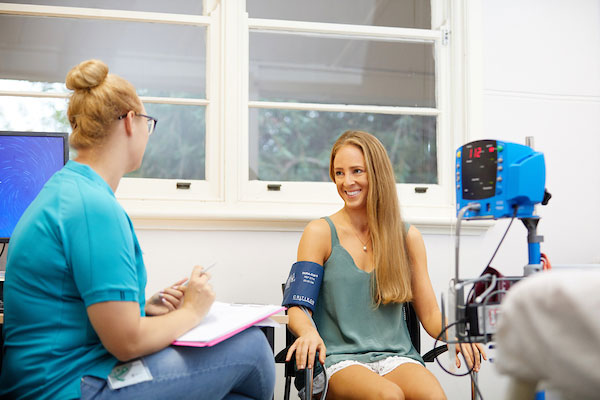The Raine Study has followed our participants for more than three decades. Our participants comprise four generations – Gen0, Gen1, Gen2 and Gen3. Until recently, follow-ups have focused on Gen1 and Gen2, however, we are now beginning to collect select data on our Gen3 and Gen0 as well.

Gen1: mothers and fathers who enrolled in the original pregnancy study between 1989 and 1991
Gen2: the children of Gen1 (born between 1989-1992)
Gen3: the children of Gen2
Gen0: the grandparents of Gen2
At each follow-up, the Raine Study collects basic measures on each participant, such as height, weight and blood pressure in order to track them longitudinally over their life course, as well as data on specific areas of research interest.
The Formation of the Cohort: 1989 – 1991
Between 1989 and 1991, 2900 pregnant women (Gen1) volunteered to be part of the study at King Edward Memorial Hospital looking at prenatal ultrasound scans at 18 weeks pregnant. Some of the mothers were followed up at 24, 28 and 38 weeks gestation. Families then continued with follow-up assessments of their babies. 2868 babies (Gen2) remained in the study and were examined on first or second day after birth by a child health nurse at King Edward Memorial Hospital.
Follow-up of infants and toddlers: 1991 – 1995
The initial follow-ups of the “Raine Study infants and toddlers” (Gen2) took place in Princess Margaret Hospital, where the Telethon Institute for Child Health Research was located. The children were examined at one, two and three years of age to assess and their growth and development recorded. The parents of the Raine Study child completed questionnaires on the child and information on the parents themselves were also collected. The infants and toddlers height, weight, blood pressure, physical health and developmental progress were measured.
Five year follow-up: 1995 – 1998
When our participants (Gen2) was five years old, parents (Gen1) were asked to complete a questionnaire and to bring their child for a physical assessment at Princess Margaret Hospital. This assessment included a lung function test, allergy testing and a hearing test as well as standard measures taken at past assessments.
Eight year follow-up: 1998 – 2000
The eight year old follow-up of the Raine Study participants (Gen2) took place at the Telethon Institute for Child Health Research. During this follow-up the Raine Study parents (Gen1) completed questionnaires and their child completed tasks in relation to reading and mathematical ability. The child also did a physical exercise test on an exercise bicycle, and the parents and child provided blood samples.
Ten year follow-up: 2000 – 2003
The ten year follow-up focused on developmental health, with an emphasis on schooling, language development, behaviour, general health, parent health and happiness. The school teachers of the participants (Gen2) provided information on the school, the children’s academic, literacy and numeracy performance as well as behaviour and special needs.
Fourteen year follow-up: 2003 – 2006
The Raine Study participants (Gen2), their primary and secondary caregivers, school teacher and school principal were asked to complete questionnaires at this follow-up. The child also attended the Telethon Institute for Child Health Research for a physical assessment. A blood sample was provided by the child and their parents. The participants (Gen2) also did lung function and allergy testing.
Seventeen year follow-up: 2006 – 2009
A range of measurements including physical fitness and motor competence, diet and nutrition, cardiovascular health, back pain, anthropometric (body composition) measurements, blood pressure, cognitive tests, liver ultrasounds and lung function testing were performed. The participants (Gen2) and their parents (Gen1), once again, also provided a blood sample. The follow-up was conducted at the Telethon Institute for Child Health Research.
Eighteen year follow-up: 2009 – 2010
When the participants (Gen2) turned 18 years of age, they were asked to complete a challenge test to examine their stress response. During the “Raine Challenge-me study” participants were involved in two separate challenge tests and their blood and saliva samples were collected to measure their peak stress hormone levels and the decline in stress hormone levels.
Twenty year follow-up: 2010 – 2012
The follow-up of the participants (Gen2) at 20 years of age was conducted at the Lions Eye Institute and participants underwent a comprehensive eye examination. They also had a DXA scan to measure bone density and body composition, as well as a fibroscan to measure liver stiffness using new technology. Male participants were also involved in a study examining male fertility.
Twenty-two year follow-up: 2012 – 2014
The 22 year follow-up of the participants (Gen2) was conducted at the University of Western Australia Centre for Sleep Science. Our main cohort had a sleep study, which involved an overnight stay and an assessment of their sleeping patterns. They also had a comprehensive lung function and asthma test, height and weight measurement, blood pressure, muscle endurance and pressure testing. The participants also provided blood samples.
Follow-up of The Raine Study Participants: 2014 – 2017
Generation 1 Sleep Study
Parents (Gen1) of participants (Gen2) who completed an overnight sleep study during the 22 year cohort follow-up were invited to attend an overnight sleep study at the UWA Centre for Sleep Science from 2014 to 2017. In addition, other tests including eyesight measurements, a DXA scan, lung function testing, pressure and cold pain testing, computer based cognitive functioning testing, blood pressure, anthropemetric testing, accelerometry and provision of a fasting blood sample were performed.
Twenty-five year old study of Workplace factors
All participants (Gen2) were sent an online questionnaire for completion. The questionnaire aimed to examine the working environment and how this affects an individual’s health, work performance and behaviour. They study also looked at how personality and demographics, and their interactions, shape or constrain individuals’ opportunities to undertake high quality work and vice versa.
Twenty-seven year old follow-ups: 2016 – 2018
This follow-up concentrated on cardio-vascular health and internal fat and involved each participant (Gen2) having an MRI scan. The MRI scan measures ectopic fat (fat around your internal organs). The participants also had height and weight measurements taken, blood pressure, whole body pressure, a fasting blood sample, faecal samples, eye testing and completed questionnaires. Female participants also had a breast density scan.
Twenty-seven year Low Back Pain MRI
Participants (Gen2) who consistently have had low back pain were invited to complete an additional assessment. The study has involved them having an MRI scan of their lower back and pelvis.
Twenty-seven year old economic survey
This study was conducted online in a game style format, looking at how our participants (Gen2) make economic and financial decisions in everyday life.
Twenty-seven year old study of workplace factors
All participants (Gen2) were once again sent a Personality, Work and Well-being online survey. For those that participated at twenty-five years old, results will be compared. Parents (Gen1) of those who participated were also invited to complete the online survey.
Follow-up of the children of The Raine Study participants: 2016 – 2018
A small group of children (Gen3) of our original Gen2 participants were invited to take part in the Raine Study to have the same measures performed on them as were done on their parents at a similar age. Information was also collected on children aged between 2 and 10 years old as a control group for the Australian Autism Bank. Family questionnaires were completed and the child’s height, weight, waist, hip and head circumference, skin folds and blood pressure were all measured. Assessments were also conducted to measure motor control and language development and biological samples collected.
Twenty-eight year follow-up: 2018 – 2021
This follow-up of our participants (Gen2) had three main aims. The first was to include the same core data as in previous follow-ups. The second was to assess artery function and health to identify factors that are associated with impaired artery function and the third was to identify the genetic and environmental factors that are associated with eye health. This included a heart ultrasound. Female participants also had a breast scan.
Study of The Raine Study grandparents (Gen0) and parents (Gen1) Breast Density: 2018 to 2019
Following the breast density scan being conducted on our main cohort (Gen2) female participants as part of the twenty-eight year follow-up, their mothers (Gen1) and grandmothers (Gen0) were invited to have the same breast density tests done for them. The device used is called TiBS (Transillumination Breast Spectroscopy) and is used to determine how much fatty tissue and dense tissue there is in breasts. Increased breast density is a strong risk factor for breast cancer in older women. At this study, the women also had their height, weight and resting blood pressure measured, complete questionnaires and had a blood sample taken.
The Generations Follow-Up: 2023-
Starting in April 2023 and running for around 3 years, the Raine Study is conducting a new follow-up that we hope will be our biggest ever – the Generations Follow-Up.
It includes two generations of participants – the original Raine Study babies (our Generation 2 participants who were born into the study from 1989-1992) as well as their biological parents (otherwise known as Generation 1). We’re calling it the Generations follow-up because it collects samples and information from two rather than just one of our participant generations at the same time, something that we have never been able to do before.
Participants are invited to complete core measures including: height, weight, blood pressure, and biosamples. Additionally, participants will receive a liver ultrasound, arterial stiffness measures, body composition scan, cognitive function assessment, activity and sleep measures, and more. You can read more about the Generations Follow-up here.
Generation 3 Follow-up: 2024 -
In 2024, The Raine Study sent a survey to all Generation 2 participants to find how many have had Generation 3 participants of their own. From this survey, The Raine Study began recruiting Generation 3 participants to join a Generation 3 Follow-up which collects core measures as well as assessments that Generation 2 participants completed in their childhood. You can read more about the Generation 3 Follow-up on our follow-up page.

